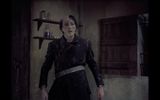SPOILERS

| Added | Wed, 27/04/2022 |
| Release date | 02-05-1957
|
| Original title | The Curse of Frankenstein
|
| Феномены | |
| References |
"The Curse of Frankenstein" (English: "The Curse of Frankenstein") – a 1957 British horror film. It became the first in the classic series of Hammer studio horror films.
A desperate prisoner sentenced to death is confessing in a prison in the supposedly Swiss town of Karlstadt. Baron Frankenstein tells the priest about how he came to this, and tries to convince him of the reality of his words.
Having inherited the title and the family fortune, he, a knowledge-hungry seeker who sought to know the mysteries of the universe, the secrets of life and death, with his senior companion and mentor, Dr. Paul Crampe, conducted experiments on the resuscitation of dead creatures. Inspired by the success of the puppy's revival, unlike the moderate, sane Crampe, he intended to go much further: go through the whole process of creating life, namely, to create a full-fledged artificial human from body parts.
To achieve this goal, he did not disdain anything: neither the banal abduction of corpses from graves, nor the bribery of gravediggers who supplied him with the sharpest eyes and the most skillful hands, nor the insidious murder of the venerable good-natured professor of philosophy Bernstein in order to get his brilliant brain. Under the pretext of caring for a poor lonely old man who did not even have the means to pay for his own decent funeral, he ordered Bernstein to be buried in his ancestral crypt.
Frankenstein was elated, but Crampe, having figured out the plan, did not share his enthusiasm. He tried to stop the prolonged experiment, especially since Frankenstein's cousin Elizabeth came to the house, wanting to marry her "loving cousin". In the altercation, Crampe accidentally knocked the jar with the brain out of the baron's hands. Fragments of the broken jar damaged the organ. The enraged Baron drove Crampe away and continued working alone. As a result, he turned out to be a monster with criminal tendencies, the elimination of which with the help of surgical and chemical means, the baron failed. Moreover, after a while the monster escaped from the laboratory.
In the forest, a monster attacked a blind old man and a boy who were collecting firewood. After a not very long search, Crampe managed to shoot the vile creature. Crampe strongly demanded that Frankenstein stop this madness, threatening not only to leave, but also to destroy the laboratory. The Baron seemed to agree, but upon returning to the laboratory, he immediately began to reanimate the monster.
The baron's maid, Justine, with whom he had a long-term affair, demanded that he fulfill his obligations to marry her, since she is expecting a child (it remains unclear whether this was a bluff or she was really pregnant). The Baron refused, and then Justine began to threaten him to tell the authorities about his experiments, hoping to achieve what she wanted by blackmail. Frankenstein got rid of the annoying witness by luring and locking her in the laboratory with a monster.
Despite attempts to control the creation, over time it got out of control. It attacked Elizabeth, after which Frankenstein was forced to destroy the monster once and for all — hit by a shot and burned by fire from a broken oil lamp, it fell through the attic window into a container with acid.
Meanwhile, the victims of the monster were found – pregnant Justine, an old man and a boy. Suspicion fell on Frankenstein. Since he failed to prove the existence of the monster, the baron was sentenced to death by guillotine.
Crampe enters the cell. The Baron rushes to him, begging him to confirm the existence of the Monster. But Crampe only coldly asks what he means. Enraged, Frankenstein attacks him, tries to force him to speak, but the guard separates them. The priest and Crampe leave, and the doctor takes Elizabeth's arm in the waiting room. The guards lead Frankenstein through the corridor into the prison yard. The last thing he (and the audience) sees is the guillotine knife rising...
Phenomena in artwork: Zombies
The revived dead in the film are a dog and a monster assembled from many parts of dead human bodies, revived by Professor Frankenstein.
In the process of reviving the creatures' bodies are placed in a special solution (the composition of which is not specified in the film) and exposed to electric current and some chemicals.
Because of the damaged brain, the monster has only the rudiments of reason and acts instinctively, reacting to external circumstances (attacks, recoils, etc.). After additional manipulations by Professor Frankenstein, who is trying to surgically restore the monster's brain, he begins to understand speech and respond to the simplest commands ("stand", "sit", "go" in the indicated direction).
After being shot in the head, the monster dies, but it manages to be revived again. Finally, it is possible to kill the monster only by dropping it into a bath with acid, "dissolving anything in a matter of hours."
Log in or register to post comments






